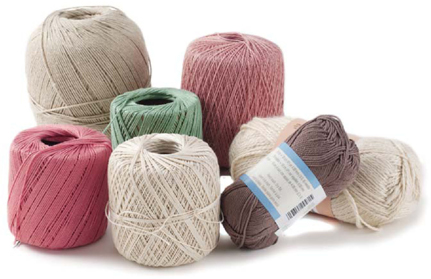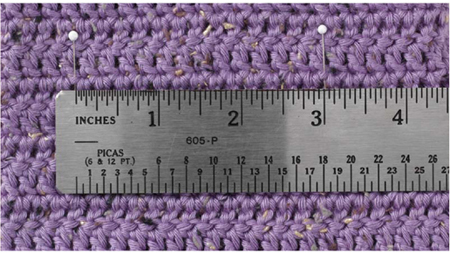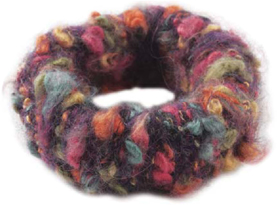BASIC INFORMATION

Stitches Used In This Book:
Chain, slip stitch, single crochet, half-double crochet, double crochet, triple crochet, double treble crochet, cluster stitch, puff stitch, popcorn stitch, clover stitch, shell stitch, bobble stitch, single crochet V-stitch, double crochet V-stitch, picot stitch, circle stitch.
Abbreviations:
|
approx. |
approximately |
|
beg |
beginning |
|
bbl(s) st |
Bobble(s) stitch |
|
blo |
back loop only |
|
CC |
contrasting color |
|
ch(s) |
chain (s) |
|
cl |
cluster stitch |
|
clo(s) st |
clover(s) stitch |
|
cont (ing) |
continue(ing) |
|
dc |
double crochet |
|
dc2tog |
double crochet two together |
|
dec(s) |
decrease(s) |
|
dtr |
double treble; also quadruple (yarn over three times) |
|
fig |
figure |
|
foll |
following |
|
gr(s) |
group(s) |
|
hdc |
half-double crochet |
|
2hdctog |
two half-double crochet together |
|
inc(s) |
increase(s)(ing) |
|
lp(s) |
loop(s) |
|
opp |
opposite |
|
oz. |
ounce(s) |
|
p |
picot |
|
patt |
pattern |
|
pc |
popcorn |
|
pm(s) |
place marker(s) |
|
prev |
previous |
|
rem |
remaining |
|
rep(ing) |
repeat(ing) |
|
rnd(s) |
round(s) |
|
RS |
right side(s) |
|
sc |
single crochet |
|
sc2tog |
single crochet two together |
|
sh(s) |
shell(s) |
|
sk |
skip |
|
sl st(s) |
slip stitch(s) |
|
sp(s) |
space(s) |
|
st(s) |
stitch(es) |
|
tch |
turning chain |
|
tog |
together |
|
tr |
triple crochet (yarn over two times) |
|
V-st |
V-stitch |
|
WS |
wrong side |
|
wt |
weight |
|
yo |
yarn over (wrap yarn around hook) |
Standard Yarn Weight System:

A Note About Gauge:
Gauge, the measurement of your stitches, is very important, especially when you are making clothing. You do not want your (supposedly) adult-sized sweater to fit a five-year-old! Believe me, it can happen very easily, even if your gauge is only off by a fraction of an inch. Follow the gauge in these patterns closely. Work up a 4″ × 4″ swatch before beginning any garment, measuring the gauge in the center of the swatch. To do that, place straight pins at the beginning and end of the designated number of stitches (or rows), and then count the number of stitches between the pins. If your gauge does not match, keep trying a larger (or smaller) hook until you get the correct gauge.
Gauge is not quite as important with scarves and purses as with the clothing, but if you want your crocheted project to look exactly like the one in the photo, you need to follow the gauge. Check it often, because when you lay a project down and come back a day, week or month later, your gauge could be quite different.
When substituting a yarn that is the same weight according to the standard yarn weight system, be sure to make a swatch and measure your gauge carefully. Yarns can fool the eye, so don't just go by the substitutions given. Yardage also varies with different yarns, and you may need more or less than the quantity specified in the pattern.

Measure gauge carefully before beginning your project.
Size Chart:
I recommend circling the size you are making on each pattern for less confusion. If you go by these measurements, the garment should fit. Keep in mind that most of the garments in this book will stretch.
Bust (at fullest point):
|
XS (0–2) |
32″–33″ |
|
S (4–6) |
34″–35″ |
|
M (8–10) |
36″–37″ |
|
L (12–14) |
38″–39″ |
|
XL (16–18) |
40″–41″ |
|
1X (18–20) |
44″–45″ |
|
2X (20–22) |
46″–47″ |
|
3X (24–26) |
48″–49″ |
To Felt:
Place the project inside a zippered pillowcase, and put it in the washing machine on the hottest, lowest water-level setting. If the water is not hot enough, turn up the heat or pour boiling water into the machine as it fills up. Place tennis shoes in the washer to help with agitation. Add 1 Tbs. detergent and ¼ cup baking soda. You may have to repeat this process 1–3 times, depending on how you want the finished project to look. Placing the piece in a sink with ice water at the end of cycle will help it to felt. Let the piece dry completely. To learn more about felting, read Felted Crochet by Jane Davis.

Directions for Striped Bracelet on pg. 15.
To Increase and Decrease:
To increase a sc, hdc or dc: Work 2 sc, 2 hdc or 2 dc in same st.
To work 1 sc decrease (2sctog): Place hook in st, yo and pull through st, with 2 lps on hook, place hook in second st, with 3 lps on hook, yo and pull through all 3 lps.
To work 1 hdc decrease (2hdctog): * Yo, insert hook in next st, yo, pull up a lp * rep from * to * once, yo and draw through all 5 lps on hook.
To work dc decrease (2dctog): Yo, insert hook in st, yo and pull lp through st, yo and pull through 2 lps on hook, yo, insert hook in next st, yo and pull lp through st, yo and pull through 2 lps on hook, yo and pull through all 3 lps on hook.